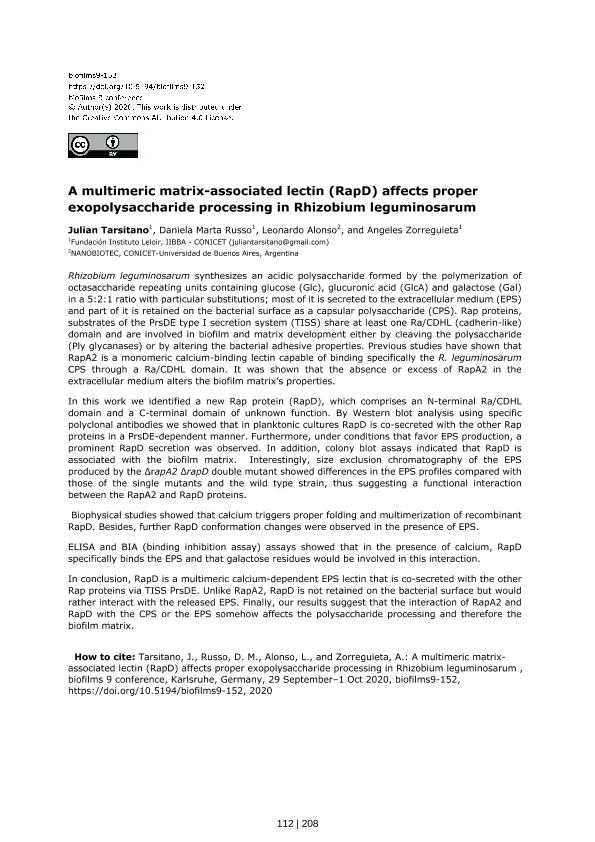Evento
A multimeric matrix-associated lectin (RapD) affects proper exopolysaccharide processing in Rhizobium leguminosarum
Tipo del evento:
Conferencia
Nombre del evento:
Proceedings of the Biofilms 9 online conference
Fecha del evento:
29/09/2020
Institución Organizadora:
Karlsruhe Institute of Technology;
Título de la revista:
Proceedings of the Biofilms 9 online conference
Editorial:
Biofilms
Idioma:
Inglés
Clasificación temática:
Resumen
Rhizobium leguminosarum synthesizes an acidic polysaccharide formed by the polymerization of octasaccharide repeating units containing glucose (Glc), glucuronic acid (GlcA) and galactose (Gal) in a 5:2:1 ratio with particular substitutions; most of it is secreted to the extracellular medium (EPS) and part of it is retained on the bacterial surface as a capsular polysaccharide (CPS). Rap proteins, substrates of the PrsDE type I secretion system (TISS) share at least one Ra/CDHL (cadherin-like) domain and are involved in biofilm and matrix development either by cleaving the polysaccharide (Ply glycanases) or by altering the bacterial adhesive properties. Previous studies have shown that RapA2 is a monomeric calcium-binding lectin capable of binding specifically the R. leguminosarum CPS through a Ra/CDHL domain. It was shown that the absence or excess of RapA2 in the extracellular medium alters the biofilm matrix's properties. In this work we identified a new Rap protein (RapD), which comprises an N-terminal Ra/CDHL domain and a C-terminal domain of unknown function. By Western blot analysis using specific polyclonal antibodies we showed that in planktonic cultures RapD is co-secreted with the other Rap proteins in a PrsDE-dependent manner. Furthermore, under conditions that favor EPS production, a prominent RapD secretion was observed. In addition, colony blot assays indicated that RapD is associated with the biofilm matrix. Interestingly, size exclusion chromatography of the EPS produced by the ΔrapA2 ΔrapD double mutant showed differences in the EPS profiles compared with those of the single mutants and the wild type strain, thus suggesting a functional interaction between the RapA2 and RapD proteins.Biophysical studies showed that calcium triggers proper folding and multimerization of recombinant RapD. Besides, further RapD conformation changes were observed in the presence of EPS. ELISA and BIA (binding inhibition assay) assays showed that in the presence of calcium, RapD specifically binds the EPS and that galactose residues would be involved in this interaction. In conclusion, RapD is a multimeric calcium-dependent EPS lectin that is co-secreted with the other Rap proteins via TISS PrsDE. Unlike RapA2, RapD is not retained on the bacterial surface but would rather interact with the released EPS. Finally, our results suggest that the interaction of RapA2 and RapD with the CPS or the EPS somehow affects the polysaccharide processing and therefore the biofilm matrix.
Palabras clave:
MATRIX
,
RAPD
,
LECTIN
,
EXOPOLYSACCHARIDE
,
RHIZOBIUM
Archivos asociados
Licencia
Identificadores
Colecciones
Eventos(IIBBA)
Eventos de INST.DE INVEST.BIOQUIMICAS DE BS.AS(I)
Eventos de INST.DE INVEST.BIOQUIMICAS DE BS.AS(I)
Eventos(NANOBIOTEC)
Eventos de INSTITUTO DE NANOBIOTECNOLOGIA
Eventos de INSTITUTO DE NANOBIOTECNOLOGIA
Citación
A multimeric matrix-associated lectin (RapD) affects proper exopolysaccharide processing in Rhizobium leguminosarum; Proceedings of the Biofilms 9 online conference; Karslruhe; Alemania; 2020; 112-112
Compartir




